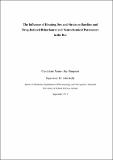| dc.description.abstract | A number of confounding factors are believed to affect both basal rodent behaviour and responsivity to psychotropic drugs. To date, few detailed comparative assessments of these confounds have been made. This thesis examined three such factors, namely, housing conditions, i.e. isolation (IC) and environmental enrichment (EE) compared to standard group conditions (SC); sex (males compared to females); and strain i.e. Wistar and Lewis compared to Sprague Dawley (SD) strain. Behavioural investigations involved the open field test (OFT), homecage activity (HCA), Morris water maze (MWM), elevated plus maze (EPM) and forced swim test forced swim test (FST). The anxiolytic effects of diazepam (DZP), antidepressant effects of desipramine (DMI) and locomotor stimulant effects of amphetamines were assessed in the EPM, FST and HCA apparatus respectively. In addition, post-mortem brain monoamine levels were assessed. OFT, homecage, EPM and FST behaviours were unaffected by housing conditions or by strain; female rats were more active in all tests and had greater percent open arm entries in the EPM than males. Latencies in the MWM were not altered. EE had few effects on monoamine levels while IC housing reduced noradrenaline (NA), dopamine (DA) and serotonin (5HT) concentrations in the brain when compared to SC controls. Female rats had reduced levels of NA, 5HT and 5-hydroxyindoleacetic acid (5HIAA) compared to males; this was somewhat dependent on housing conditions however as sex differences were primarily observed in SC- and EE- reared rats. Lewis rats had significantly greater NA, 5HIAA and 5HT turnover in the hippocampus compared to SD and Wistar rat strains. The anxiolytic effects of diazepam in the EPM were blunted following EE rearing and in female rats but enhanced in the Lewis strain. Similarly, antidepressant effects of DMI were blunted for rats reared in social groups and in female rats. Finally the effects of stimulant drugs were enhanced by social housing conditions, in female rats and the Lewis strain; while stimulant effects were blunted in IC-housed and Wistar rats. In summary, baseline behaviour was most affected by sex differences, whilst psychotropic drug responses were affected by IC and EE housing, sex and strain. Monoamine levels differed according to housing conditions, sex and, to lesser extent, strain. These effects highlight the sensitivity of commonly-employed behavioural pharmacology tests to such variables. These findings stress the importance of appropriate subject selection in the design of behavioural and neurochemical studies. | en_US |


